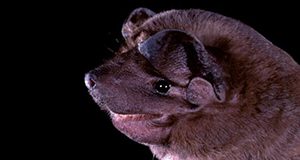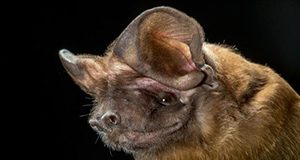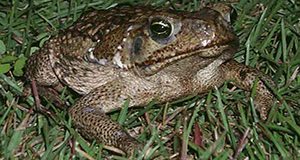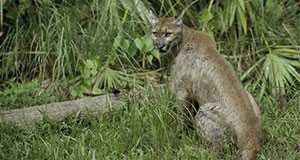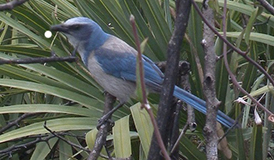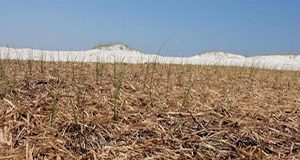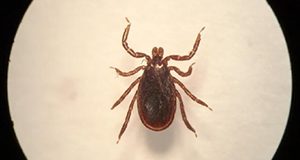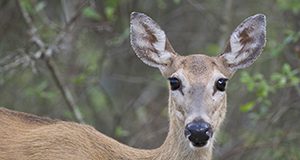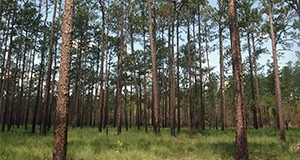The velvety free-tailed bat is found nowhere in the United States but extreme south Florida. These bats emerge from their roosts earlier than most other bats, often shortly before sunset. This 2-page fact sheet written by Holly K. Ober, Terry Doonan, and Emily Evans, and published by the UF Department of Wildlife Ecology and Conservation explains how to differentiate velvety free-tailed bats from Brazilian free-tailed bats and Florida bonneted bats.
http://edis.ifas.ufl.edu/uw425
Tag: Department of Wildlife Ecology and Conservation
Florida's Bats: The Florida Bonneted Bat
The Florida bonneted bat is one of only two endangered species of bat in Florida and the state’s only endemic flying mammal (“endemic” means that it is found nowhere in the world but in Florida). With a 20-inch wingspan, it is Florida’s largest bat and the third largest of all 48 species of bats in the United States. The Florida bonneted bat was listed as federally endangered in 2013 because of concerns over habitat loss, degradation, and modification caused by humans. Additional concerns include the species’ small population size and restricted range, the small number of known colonies, their slow reproduction, and the relative isolation of separate populations of bonneted bats. This 2-page fact sheet written by Holly K. Ober, Terry Doonan, and Emily Evans, and published by the UF Department of Wildlife Ecology and Conservation explains how to differentiate Florida bonneted bats from velvety free-tailed bats and Brazilian free-tailed bats and explains what to do if you find one of these endangered bats.http://edis.ifas.ufl.edu/uw426
Ecological Risk Assessment for Invasive Wildlife in Florida
Global trade and travel transport plants and animals from native ranges to new ecosystems. About 10 to 20% of nonnative (exotic, alien) species that arrive in new locales become invasive, meaning they are likely to harm the environment, economy, or public health. Preventing the introduction of invasive species is the most effective way to protect native biodiversity and ecosystem integrity. Once an invader begins to establish and spread, its control costs increase rapidly. Florida ports are the entry points for about half of the reptiles, arachnids, insects, and crustaceans imported into the United States. These arrivals, coupled with hospitable climate and habitats, have made Florida home to more invasive species than any other state but Hawaii. While it is too late to prevent the invasion of Burmese pythons and Argentine black and white tegus, we can act to prevent other potentially destructive species from establishing. This 6-page fact sheet written by Venetia Briggs-Gonzalez, Kyle Allen, Rebecca G. Harvey, and Frank J. Mazzotti and published by the Department of Wildlife Ecology and Conservation explains how to assess the risk that a given invasive species presents to the environment and how to develop and use risk-screening tools to reduce the harmful effects of invasions or, better yet, prevent them entirely.
http://edis.ifas.ufl.edu/uw419
The American Crocodile: An Indicator Species for Everglades Restoration

The American crocodile (Crocodylus acutus) is a top predator that lives along the southern tip of peninsular Florida, inhabiting saltwater, brackish water, or freshwater near coastal areas in mangrove-lined ponds, creeks, coves, man-made ponds, and canals. This 3-page fact sheet written by Rebecca G. Harvey, Michiko Squires, Jeff Beauchamp, Frank J. Mazzotti, and Laura A. Brandt and published by the Department of Wildlife Ecology and Conservation explains how monitoring populations of threatened crocodiles can help scientists chart the success of projects to restore the Everglades.
edis.ifas.ufl.edu/UW422
Government Efforts to Protect Habitat for the Florida Panther on Private Lands
Endangered Florida panthers live and breed on state and federal lands in south Florida, but they are a wide-ranging species, and the habitat available to them on public lands is not enough for them to thrive and recover. The 2008 Panther Recovery Plan by the US Fish and Wildlife Service requires that habitat for the panther be conserved on both public and private lands throughout the state. Private rangelands in southwest and south central Florida provide important habitat and prey for the Florida panther. These lands also play a key role in conserving other native species like gopher tortoises, bob white quail, turkeys, deer, vultures, scrub jays, cranes, black bears, and bobcats. Unfortunately, these rangelands are under increasing development pressure as the human population in Florida continues to grow. Multiple policy approaches have been put in place by local, state, and federal governments to address habitat loss and secure natural resources in Florida for our panthers. This 5-page fact sheet written by Elizabeth F. Pienaar and Melissa M. Kreye and published by the Department of Wildlife Ecology and Conservation provides a brief overview of existing regulatory and voluntary approaches to help conserve the Florida panther on private lands.
http://edis.ifas.ufl.edu/uw413
Considerations for Building Climate-Based Species Distribution Models
Climate plays an important role in the distribution of species. A given species may adjust to new conditions in-place, move to new areas with suitable climates, or go extinct. Scientists and conservation practitioners use mathematical models to predict the effects of future climate change on wildlife and plan for a biodiverse future. This 8-page fact sheet written by David N. Bucklin, Mathieu Basille, Stephanie S. Romañach, Laura A. Brandt, Frank J. Mazzotti, and James I. Watling and published by the Department of Wildlife Ecology and Conservation explains how, with a better understanding of species distribution models, we can predict how species may respond to climate change. The models alone cannot tell us how a certain species will actually respond to changes in climate, but they can inform conservation planning that aims to allow species to both adapt in place and (for those that are able to) move to newly suitable areas. Such planning will likely minimize loss of biodiversity due to climate change.
http://edis.ifas.ufl.edu/uw420
Building Coastal Dunes with Sea Oats and Surrogate Wrack
Perennial coastal grasses such as sea oats have long been recognized as the biological engineers of our increasingly stressed beaches and coastal dunes. Sea oats build dunes by capturing blowing sand and stabilizing it, and they’re often planted after dunes have been eroded, fragmented, or destroyed. Managers have tried commercial fertilizers and water-absorbing gels to ensure planted sea oats survive and thrive, but these products are not always effective and can be expensive. Removal of natural beach litter, called “wrack” and defined as “algae, grasses, driftwood, fruits, seeds, and carrion, along with cultural litter,” has frequently had the undesired effect of weakening the establishment and growth of sea oats. A relatively cheap and effective method to restore them is to reproduce the beneficial effects of this beach litter with “surrogate wrack.” This 4-page fact sheet written by Natalie Hooton, Debbie Miller, Mack Thetford, and Sean Claypool and published by the Department of Wildlife Ecology and Conservation describes the promising results of a study into the feasibility and effectiveness of surrogate wrack to help sea oats become established and grow more quickly and vibrantly to restore dunes and beaches.
edis.ifas.ufl.edu/uw409
Facts about Wildlife Diseases: South Tick Associated Rash Illness or "STARI"
Southern tick-associated rash illness (STARI) is a human tick-borne disease that occurs following the bite of Amblyomma americanum, the lone star tick, which is the most common and aggressive human-biting tick in the South, accounting for over 90% of human tick bites in the region. STARI is often described as a “Lyme-like illness” because it causes a rash like the “bulls eye” rash associated with Lyme. Other symptoms of STARI that are similar to symptoms of Lyme disease include headache, fatigue, and muscle and joint pain. Scientists know the tick vector and that some wildlife species play a role in maintaining the disease in nature, but very little else is understood about this mysterious illness. This 4-page fact sheet written by Katherine Sayler, Carisa Boyce, and Samantha Wisely and published by the Department of Wildlife Ecology and Conservation provides the basic facts we do know, the differences between STARI and Lyme disease, plus advice for tick-bite sufferers and strategies to avoid tick bites.
http://edis.ifas.ufl.edu/uw421
Facts about Wildlife Diseases: Hemorrhagic Fever in White-Tailed Deer
The viruses that cause hemorrhagic disease (HD) in deer do not cause illness in people, but they are a growing problem. HD is the most important viral disease of white-tailed deer in the United States. Large outbreaks have occurred in the northern Midwest and western United States. In Florida outbreaks are fewer and less severe in populations of wild white-tailed deer than are outbreaks among wild deer in other areas of the United States, but farm-raised deer in the state are proving vulnerable to epizootic hemorrhagic disease virus: one of the viruses that cause HD. This 6-page fact sheet written by Katherine A. Sayler, Charlotte Dow, and Samantha M. Wisely and published by the Department of Wildlife Ecology and Conservation describes best management techniques for outbreaks of HD in farm-raised deer. It includes strategies for best supportive care for sick animals, diagnostics, and integrated pest management to control biting midges that spread the viruses that cause HD, because the best way to manage HD is to prevent it.
http://edis.ifas.ufl.edu/uw411
History and Status of Introduced Rhesus Macaques (Macaca mulatta) in Silver Springs State Park, Florida
Local folklore suggests that the rhesus macaque monkeys living in what is today Silver Springs State Park were released while the 1939 movie Tarzan "Finds a Son" was filmed at the site, but no rhesus macaques appear in that movie, and the macaques had been living in Silver Springs for a considerable time before Tarzan found his son there. In fact, today’s thriving population of macaques in Silver Springs State Park descended from monkeys intentionally released earlier in the 1930s in an effort to increase tourism to the area.
Silver Springs became a tourist attraction in the 1870s and has had glass-bottom boat tours ever since. In the 1930s the manager of the glass bottom boat operation, Colonel Tooey, released approximately six rhesus macaques to attract tourists and increase revenue for the boat tours. Not knowing rhesus macaques are proficient swimmers, Colonel Tooey released his monkeys on an island in the Silver River from whence they quickly swam to the surrounding forests, where they made themselves at home and set up a growing colony. What happened next? Learn the story (so far!) of the monkeys and the park in this 4-page fact sheet written by C. J. Anderson, S. A. Johnson, M. E. Hostetler, and M. G. Summers and published by the Department of Wildlife Ecology and Conservation.
edis.ifas.ufl.edu/uw412
Landowner Cost-Share Incentives and Payments for Ecosystem Services: A Comparison of Key Program Features
Landowners who conduct land management activities that protect environmental benefits may be eligible for several types of financial assistance from the government, but not all incentive strategies are the same. This 4-page fact sheet written by Melissa M. Kreye, Elizabeth Pienaar, and Raoul K. Boughton and published by the Department of Wildlife Ecology and Conservation compares traditional cost-share programs offered to landowners through federal agencies and a new type of market-based incentive program called payments for ecosystem services (PES). The information inside can help private landowners understand the advantages and limitations of both approaches and guide decision-makers in designing effective future conservation incentive programs.
edis.ifas.ufl.edu/uw415
Using the Ecosystem Services Approach to Advance Conservation Efforts on Private Lands
Decision-makers in Florida have shown increased interest in using the Ecosystem Services (ES) approach to reward ecosystem conservation efforts on private lands. For example, payments for ecosystem services (PES) strategies have been effective in motivating landowners to conserve ecosystems on their land. Some landowners may find a better understanding of the ES approach to be useful when deciding to participate in a PES program. This 5-page fact sheet written by Melissa M. Kreye, Elizabeth Pienaar, Raoul K. Boughton, and Lindsey Wiggins and published by Department of Wildlife Ecology and Conservation will provide landowners, Extension agents, government and agency leaders, and other stakeholders with a better understanding of how ES are classified, the different ways ES can be valued, how quantifying ES values can help support conservation efforts on private lands in Florida, and a few of the challenges inherent in using the ES approach.
edis.ifas.ufl.edu/uw414
Temporary Food Plot Deterrents for Deer: Do They Work?
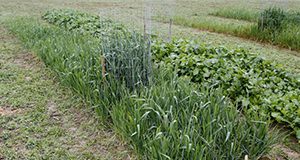
Many Floridians enjoy the opportunity to hunt, watch, or photograph white-tailed deer. Hunters and landowners often plant cool season forage plots both to attract wildlife and to provide a dependable food source. But where there is a high deer population or scarce food resources, deer may forage on food plots as soon as the plants emerge and before they become established. This fact sheet presents the results of research conducted at the UF/IFAS North Florida Research and Education Center in Quincy into the effectiveness of various strategies hunters and landowners can use to temporarily limit access to new food plots until the plants are well established and strong enough to attract and sustain hungry deer through the winter. Written by Holly Ober, Cheryl Mackowiak, and Ann Blount and published by the UF/IFAS Department of Wildlife Ecology and Conservation.
http://edis.ifas.ufl.edu/uw410
